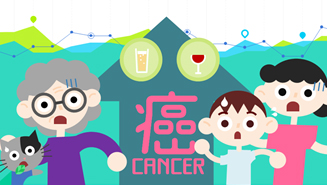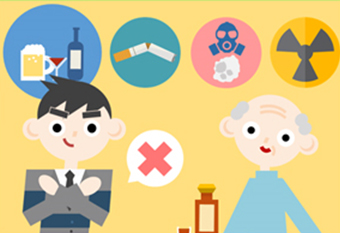Alcohol and Cancer
 Alcohol consumption, like smoking, is one of the most well-established causes of cancer in humans. But unlike the case with tobacco smoke, the fact that alcoholic beverages cause cancer is not well-known among health professionals, and much less so by the public. It barely makes sense to drink for your good health.
Alcohol consumption, like smoking, is one of the most well-established causes of cancer in humans. But unlike the case with tobacco smoke, the fact that alcoholic beverages cause cancer is not well-known among health professionals, and much less so by the public. It barely makes sense to drink for your good health.
Well-established cause of cancer

- “Ethanol in alcoholic beverages” and “acetaldehyde associated with alcohol consumption” (acetaldehyde is the main metabolite of ethanol in the body) have both been classified as Group 1 carcinogens, the same category as tobacco smoke, ionising radiation and asbestos1, by the International Agency for Research on Cancer (IARC) of the World Health Organization, because there has been sufficient evidence in humans that alcohol causes cancer).
- Human and animal studies revealed several mechanisms through which alcohol may contribute to an increased risk of cancer. Ethanol and acetaldehyde can damage DNA, increase the level of oestrogen (which is important for breast carcinogenesis), act as solvents for tobacco carcinogenesis, produce reactive oxygen species and nitrogen species, and change folate metabolism.
Alcohol causes cancer and has no safe level

- Epidemiologic studies have clearly indicated that alcohol drinking causes cancers of oral cavity, pharynx (excluding nasopharynx), larynx, oesophagus, liver, colorectum, and female breasts.
- The risks of these cancers also rise with increasing alcohol use.
- Alcohol’s carcinogenic effect is independent of the type of alcoholic beverages. In other words, the carcinogenic effect is the same for beer, wine or spirits.
- When it comes to cancer risk, there is NO safe level for alcohol consumption. Regular alcohol use, even consumed in only small amounts, increases the risk of dying of cancer.
- So, the sound advice is not to start drinking at all. For current drinkers, if they stop drinking now, their cancer risk will gradually return to that before they started drinking.
1 Note: The IARC classifications describe the strength of the scientific evidence about an agent being a cause of cancer, rather than assessing the level of risk. That is to say, even though alcohol and tobacco smoke are assigned to the same category, this does not imply they are at equal risk of causing cancer.
How alcohol increases risk of cancer?
The following shows the increased risks of morbidity/mortality of cancers due to different amount of alcohol consumed every day:
| 12 g/day | 24 g/day | 36 g/day | 48 g/day | 60 g/day | 72 g/day | |||
| 1 | Lip and oral cancer | +29%* | +74%* | +131%* | +199%* | +277%* | +386%* | |
| 2 | Nasopharynx cancer | +37%* | +84%* | +139%* | +206%* | +280%* | +355%* | |
| 3 | Other pharynx cancer | +47%* | +94%* | +152%* | +220%* | +297%* | +376%* | |
| 4 | Oesophageal cancer | +21%* | +47%* | +82%* | +120%* | +145%* | +167%* | |
| 5 | Larynx cancer | +12% | +30%* | +53%* | +81%* | +114%* | +146%* | |
| 6 | Colon and rectum cancer | +8%* | +16%* | +24%* | +32%* | +47%* | +62%* | |
| 7 | Liver cancer | +7% | +14% | +23%* | +31%* | +37%* | +42%* | |
| 8 | Breast cancer | +17%* | +33%* | +43%* | +44%* | +45%* | +48%* | |
| Legends: *Statistically significant change |
||||||||
Source: Adopted from Lancet 2017; 390:1345-422
Note: In Hong Kong, a typical serving size of beer (1 can, 330ml, 5% alcohol content), a typical serving size of wine (1 serving glass, 125ml, 12% alcohol content) in restaurants, and most servings of mixed alcoholic drinks will contain about 12g of alcohol.
- Alcohol causes cancer and should not be used for improving health.
- If you don’t drink, do not start drinking.
- If you choose to drink, limit your drinking after knowing the risk to minimise alcohol harm.
- Please note there is no safety level for drinking.
- For your health and lowering risk of cancers, you can reduce your drinking step by step. Staying sober is the best option.
- Children, adolescents and pregnant women should not drink.
You may also wish to know: